![]()
![]()
![]()
Use LEFT and RIGHT arrow keys to navigate between flashcards;
Use UP and DOWN arrow keys to flip the card;
H to show hint;
A reads text to speech;
91 Cards in this Set
- Front
- Back
|
Heredity |
Transmission of traits from one generation to the next |
|
|
Variation |
Demonstrated by the differences in appearance that offspring show from parents and siblings |
|
|
Genetics |
Scientific study of hereditary and variation |
|
|
Offspring acquire genes from parents by... |
Inheriting chromosomes Genes are inherited, not physical characteristics |
|
|
Units of heredity... |
Genes Made up of segments of DNA Passed on to the next generation via reproductive cells (gametes) |
|
|
Reproductive cells |
Gametes Sperm and eggs |
|
|
Somatic cells |
All cells of the body except gametes and their precursors |
|
|
Chromosomes |
Humans have 46 in the nuclei of their somatic cells Most DNA is packaged in chromosomes |
|
|
Locus |
A genes specific position along a chromosome |
|
|
Asexual reproduction |
Genes are passed on to offspring without the fusion of gametes Multicellular organisms are capable of this like an amoeba Reproducing this way creates a clone (genetically identical) |
|
|
Sexual reproduction |
2 parents give rise to offspring that have unique combinations of genes inherited from the two |
|
|
Humans have ——pairs of chromosomes |
23 In pairs called homologous or homologs |
|
|
Chromosomes in a pair.. |
Are same length and shape |
|
|
Karyotype |
An ordered display of the pairs of chromosomes from a cell |
|
|
Sex chromosomes |
Determines sex of an individual X and Y Males are XY and females are XX |
|
|
Autosomes |
Remaining 22 pairs of chromosomes outside of the sex chromosomes |
|
|
Each pair of homologous chromosomes includes... |
One chromosomes from each parent |
|
|
Diploid cell |
2n Has 2 sets of chromosomes Diploid number for human cells is 46 (2n=46) |
|
|
Haploid cells |
A gamete ( sperm or egg) contains a single set of chromosomes |
|
|
Haploid number in humans is |
23 (n=23) Each set of 23 consist of 22 autosomes and a single sex chromosome |
|
|
Sex chromosome in egg versus sperm |
Make-X or Y Female-X |
|
|
Human life cycle begins when a haploid sperm fuses with a.. |
Haploid egg |
|
|
Fertilization |
Union of gametes Fusion of their nuclei |
|
|
Zygote |
Fertilized egg Has one set of chromosomes from each parent Produces somatic cells by mitosis and develops into an adult |
|
|
The only cells not produced by mitosis.. |
Gametes which develop from special germ cells in gonads Produced by meiosis Reduces chromosomes to one set in each gamete |
|
|
Fertilization restores the diploid... |
Combines 2 sets of chromosomes |
|
|
Meiosis |
A type of cell division that reduces number of sets of chromosomes from 2-1 |
|
|
Variety of sexual life cycles |
3 main types Differ in timing of meiosis and fertilization |
|
|
Alternation of generation |
Plants and species of algae exhibit a second type of life cycle Includes diploid stage (sporophyte) and haploid cells (spores) |
|
|
3rd type of life cycle occurs in |
Fungi and some protist |
|
|
Meiosis reduces the number of chromosomes sets from ____ to _____ |
Diploid to haploid Takes places in 2 consecutive cell divisions: meiosis I and meiosis II Results in 4 daughter cells (rather than 2 in mitosis) Each daughter cell has only half as many chromosomes as parent cell |
|
|
Stages of meiosis |
Chromosomes duplicate during interphase Resulting sister chromatids are closely associated length-wise (chromatid cohesion) Chromatids are sorted into 4 haploid daughter cells (different from mitosis) |
|
|
Meiosis I |
4 phases: Prophase, metaphase, anaphase, telephase /cytokinesis |
|
|
Prophase I |
Centrosome movement, spindle formation, nuclear envelop break down Chromosomes pair with homologous and cross over Chiasmata occurs Microtubles move homologous pairs toward the metaphase plate
|
|
|
Metaphase I |
Pairs of homologous chromosomes are arranged at metaphase plate Both are attached to microtubles from one pole and the other to the other |
|
|
Anaphase I |
Breakdown of proteins that hold cohesion of sister chromatid Allows to separate Move to opposite poles Cohesion continues at centromere |
|
|
Telephase I and Cytokinesis |
In tele: each half of cell has a complete haploid set of chromosomes Cyto: occurs simultaneously with telephase forming 2 haploid daughter cells Cleavage forms in animals, in plants-a cell plate In some species chromosomes deco dense and nuclear envelope forms |
|
|
Chiasmata |
X-shaped regions on homologous pair where crossovers occurred In prophase I |
|
|
Crossing over |
Chromosome pairs align gene to gene and then dNa molecules of nonsister chromatids are broken and rejoined together |
|
|
Prophase II |
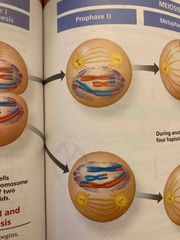
Spindle apparatus forms Chromosomes of 2 chromatids associated at centromeres moved by microtubles |
|
|
Metaphase II |
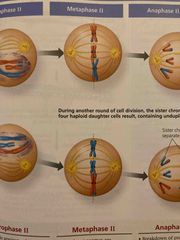
Chromosomes are at metaphase plate Due to crossing over in meiosis I, sister chromatids are not genetically identical The kinetochores are attached to microtubles |
|
|
Anaphase II |
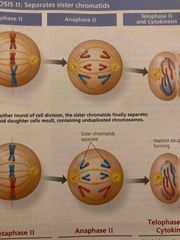
Breakdown of proteins sister chromatids together at centromere Separate and move towards opposite poles as individual chromosomes |
|
|
Telophase II & cytokinesis |
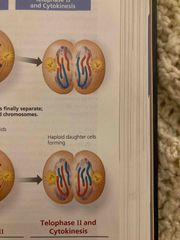
Chromosomes begin condensing Nuclei form Cytokinesis begins The meiotic division of one parent cell produces 4 daughter cells each with a haploid set of chromosomes The 4 daughter cells are genetically distinct form one another and the parent cell |
|
|
Genetic variation |
Mutations (change in DNA) are original source of genetic diversity Mutations create different versions of genes called alleles Reshuffling of alleles during sex reproduction produces genetic variation |
|
|
Three ways for genetic variation |
1. Independent assortment of chromosomes 2. Crossing over 3. Random fertilization |
|
|
Crossing over and synapses during prophase I part 1 |
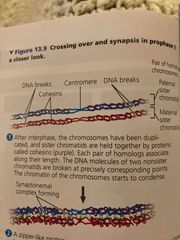
1. Homologs are aligned. DNA molecules on nonsister (one mom, one dad) chromatids are broken and start to condense |
|
|
Crossing over and synapses during prophase I part 2 |

2. Zipper like structure called synaptonemal complex forms Attached one homolog to the other |
|
|
Crossing over and synapses during prophase I part 3 |
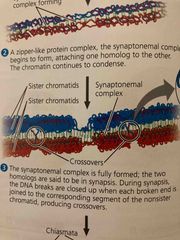
Synapsis (green-connecting) DNA breaks are closed up so that each end is joined with the corresponding segment of the nonsister chromatid |
|
|
Crossing over and synapses during prophase I part 4 |
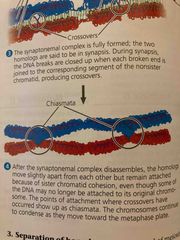
These crossover points become visible as chiasmata (sing.=chiasma) Synaptonemal complex dissembles At least one crossover per pair must happen in order for homologous pair to stay together |
|
|
Mitosis vs meiosis |
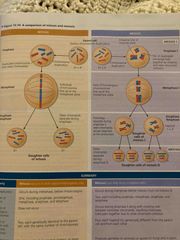
Differ genetically vs genetically identical Reduces the number of chromosomes sets from 2 to 1 vs conserves the number of chromosome sets 3 events unique to meiosis |
|
|
Anaphase II |
Breakdown of proteins sister chromatids together at centromere Separate and move towards opposite poles as individual chromosomes |
|
|
Telophase II & cytokinesis |
Chromosomes begin condensing Nuclei form Cytokinesis begins The meiotic division of one parent cell produces 4 daughter cells each with a haploid set of chromosomes The 4 daughter cells are genetically distinct form one another and the parent cell |
|
|
Each daughter cell is |
Genetically distinct from others and parent cell |
|
|
Each gene on one homolog |
Is aligned precisely with the corresponding allele of that gene on the other homolog ie: eye color match eye color |
|
|
Independent assortment of chromosomes |
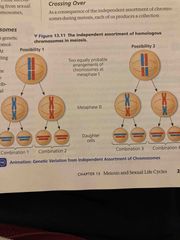
Homologous pair of chromosomes orient randomly at metaphase I Sorts maternal and paternal chromosomes homologs into daughter cells independent of the other pairs Number of possible combinations: 2^n so In humans this is 2^23 |
|
|
Crossing over |
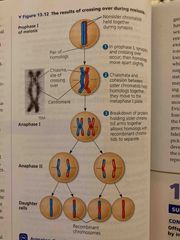
Recombinant chromosomes: chromosomes that carry genes from two different parents (mix DNA from each parent into a Sinhalese chromosome) Average of 1-3 crossovers in humans |
|
|
Crossing over and synapses during prophase I part 3 |
Synapsis (green-connecting) DNA breaks are closed up so that each end is joined with the corresponding segment of the nonsister chromatid |
|
|
Crossing over and synapses during prophase I part 4 |
These crossover points become visible as chiasmata (sing.=chiasma) Synaptonemal complex dissembles At least one crossover per pair must happen in order for homologous pair to stay together |
|
|
Mitosis vs meiosis |
Differ genetically vs genetically identical Reduces the number of chromosomes sets from 2 to 1 vs conserves the number of chromosome sets 3 events unique to meiosis |
|
|
Dominant alleles that cause disease |
Rare Arise by mutation Lethal dominant alleles kill offspring before they can mature and reproduce, allele will not be passed on to future generations |
|
|
Chorionic villus sampling (CVS) |
8th-10th week Alternative to amniocentesis Placenta is removed and tested |
|
|
Cell-free fetal DNA (off DNA) |
Isolation of fetal cells or DNA from mothers blood 10 weeks |
|
|
Ultrasound and fetoscopy |
Visually assess health of fetus |
|
|
Phenylketonuria (PKU) |
A recessive inherited disorder that occurs in one of every 10-15,0000 births in US |
|
|
Extra |
O |
|
|
Extra |
O |
|
|
Achondroplasia |
A form of dwarfism caused by a rare dominant allele (chr 4) Heterozygous individuals have the phenotype |
|
|
Huntington’s disease |
Degenerative disease of the nervous system No phenotype effects until age 35/40. Once the deterioration of nervous system begins, condition is irreversible and fatal Mutated copy of gene for a protein called huntingtin (chr 4) |
|
|
Percentage child will inherit Huntington’s disease from parent who has the allele |
50% |
|
|
Dominant allele |
I |
|
|
Multifactorial disorders |
Many diseases have both genetic and environmental components Genotype typically polygenic No matter what genotype, lifestyle has an affect on phenotype |
|
|
The best public Heath strategy is education about relevant environmental factors and promotion of healthy behaviors |
Preventive healthcare |
|
|
Using family histories genetic counseling helps couples determine odds that their children will have genetic disorders |
It is important to remember that each child represents an independent event ie: John and carol: to determine if carriers, couple would be either AA or Aa. Each have 2/3 chance so 2/3x2/3x1/4(chance of 2 carriers having a child with disease)= 1/9 chance they will have |
|
|
Testing for carriers |
Growing number of diseases are tested Test enable people to make informed decisions Raises issues as to whether affected individuals fully understand their genetic test results |
|
|
Amniocentesis |
Fetal testing for some genetic disorders 14th-16th week |
|
|
Dominant alleles that cause disease |
Rare Arise by mutation Lethal dominant alleles kill offspring before they can mature and reproduce, allele will not be passed on to future generations |
|
|
Chorionic villus sampling (CVS) |
8th-10th week Alternative to amniocentesis Placenta is removed and tested |
|
|
Cell-free fetal DNA (off DNA) |
Isolation of fetal cells or DNA from mothers blood 10 weeks |
|
|
Ultrasound and fetoscopy |
Visually assess health of fetus |
|
|
Dominant allele |
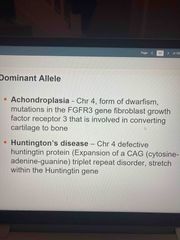
I |
|
|
Extra |
O |
|
|
Extra |
O |
|
|
Using family histories genetic counseling helps couples determine odds that their children will have genetic disorders |
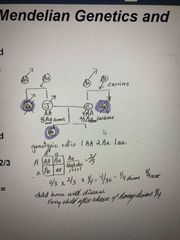
It is important to remember that each child represents an independent event ie: John and carol: to determine if carriers, couple would be either AA or Aa. Each have 2/3 chance so 2/3x2/3x1/4(chance of 2 carriers having a child with disease)= 1/9 chance they will have |
|
|
Huntington’s disease |
Degenerative disease of the nervous system No phenotype effects until age 35/40. Once the deterioration of nervous system begins, condition is irreversible and fatal Mutated copy of gene for a protein called huntingtin (chr 4) |
|
|
Amniocentesis |
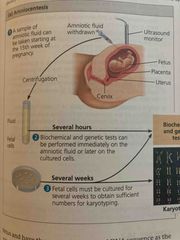
Fetal testing for some genetic disorders 14th-16th week |
|
|
Chorionic villus sampling (CVS) |

8th-10th week Alternative to amniocentesis Placenta is removed and tested |
|
|
Multifactorial disorders |
Many diseases have both genetic and environmental components Genotype typically polygenic No matter what genotype, lifestyle has an affect on phenotype |
|
|
The best public Heath strategy is education about relevant environmental factors and promotion of healthy behaviors |
Preventive healthcare |
|
|
Using family histories genetic counseling helps couples determine odds that their children will have genetic disorders |
It is important to remember that each child represents an independent event ie: John and carol: to determine if carriers, couple would be either AA or Aa. Each have 2/3 chance so 2/3x2/3x1/4(chance of 2 carriers having a child with disease)= 1/9 chance they will have |
|
|
Extra |
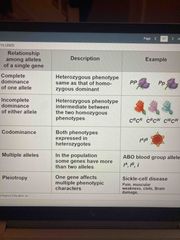
O |
|
|
Extra |
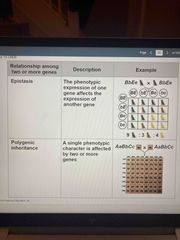
O |

